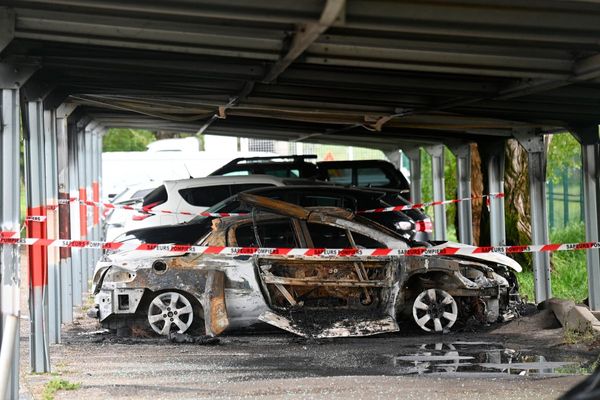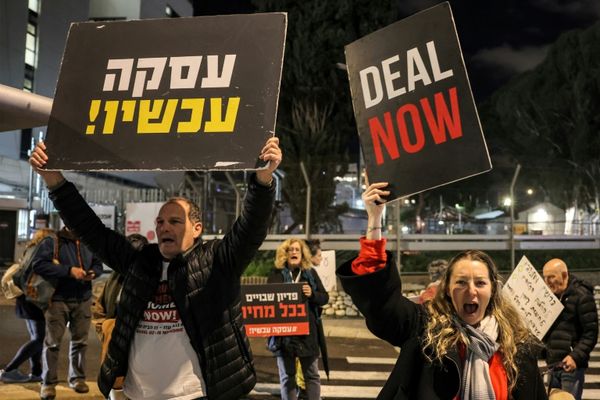
Demobilised Israeli reservists have described how they deployed massive fire power in a brutal, complex and often one-sided war of sporadic but intense clashes that has reduced much of Gaza to ruins.
They spoke, too, of the challenge of fighting on unfamiliar ground that is well-known to Hamas and which offered easy opportunities for surprise attacks, despite Israel’s conventional military superiority and air power.
Some had not seen Palestinian civilians at all, passing weeks in Gaza without encountering anyone other than small bands of Hamas militants. Others said they had been in close combat almost every day and considered those civilians who ignored Israeli instructions to flee as complicit with Hamas and thus legitimate targets. Those interviewed also expressed sympathy for civilians and said they had tried to help them.
More than 27,700 Palestinians have been killed in Gaza since 7 October, mostly women and children, according to Palestinian health officials. Many thousands more are buried in the rubble. Swathes of Gaza have been destroyed and 1.9 million of its 2.3 million people have been displaced.
Senior military officials have said the offensive could last for many more months, even into 2025.
The soldiers were not authorised to speak to the media and were interviewed by the Guardian on condition of anonymity.
Information about the actual experience of fighting in the conflict has been closely controlled by the Israeli authorities. Journalists have been barred from Gaza, except for short, carefully supervised trips with the Israeli Defense Forces (IDF).
The IDF did not act on repeated requests by the Guardian to speak to serving soldiers who had fought in the Israel-Gaza war.
“The destruction is massive,” said one noncommissioned officer (NCO) who was in Gaza for two months with an infantry unit. “What really blew my mind was that there is nowhere for anyone to come back to. There aren’t even three walls connected. It looks like a scene of a zombie attack or something. It’s not a war zone. It’s a disaster area, like out of Hollywood.”
A recently returned veteran said: “It’s not like how you see in the media. It’s not like a computer game. There are days and days when nothing happens and you never see the terrorists then it all goes crazy for an hour or so then nothing again.”
Other demobilised reservists described intensive combat with close-quarter fighting in Hamas strongholds such as Shujaiya and Jabaliya camp.
Israel launched the offensive after a bloody surprise attack by Hamas into Israel on 7 October that killed 1,200 people, mostly civilians in their homes or at a music festival. About 240 hostages were taken back to Gaza by the group.

Reservists described fighting an enemy they barely saw for more than “a few milliseconds”.
“They don’t show themselves. They avoid contact. You see the targets for a milliseconds. It’s kind of weird. You are walking through this smashed up city but it is empty. You have all this destructive power – attack helicopters, tanks, artillery that you can call for – so you feel almost omnipotent. But then at the same time you feel vulnerable,” the NCO said.
Many of those interviewed spent days trying to find and destroy a tunnel network that, they said, was far more extensive than originally thought by Israeli military planners and which allowed their enemies to emerge unexpectedly to attack.
“I was meant to be mapping [the tunnels] but in the end I just concentrated on the main tunnels, worked out where they were and then we bombed anything that we thought might be other tunnels for 2 kilometres all around,” said one.
Another said the tunnels were “all over the place, in houses, next to schools, in wasteland”.
“We tried all sorts of things to find them. Cameras on wires, going down ourselves. We were putting smoke grenades down them at one point and then looking for where the smoke came out,” he said.
Israeli officials have said that Hamas deliberately uses civilians to protect its military infrastructure and fighters, a charge denied by the Islamist group.
Officers interviewed by the Guardian in Gaza in November said the IDF warned civilians to leave in advance of any assault with telephones, media, flyers and bullhorns. Earlier in the conflict, the IDF organised what it called humanitarian corridors to allow ordinary residents of northern Gaza to evacuate and dropped leaflets telling them to flee. Aid agencies, however, have questioned the effectiveness of such orders, insisting that nowhere in the territory is safe amid Israel’s intensive bombardment campaign.

The interviews suggest that the soaring civilian death toll is at least in part due to Israel’s use of massive fire power to limit its own losses.
One soldier from the special forces Duvdevan unit said his unit had only encountered Hamas militants on three occasions during six weeks in north Gaza, from where the majority of civilians were ordered to evacuate early in the war.
When asked what tactics the unit employed in such situations, the soldier laughed.
“There are no tactics. We take some fire and identify a target. For an hour we unload everything we’ve got, our own weapons, tanks, anything we can get. Then we advance and find dead terrorists,” he said.
Another special forces soldier said that advances were “done properly” during the early stages of the war.
“We had everything we needed and all in the right order. First airstrikes and artillery, then the tanks, and only then the foot soldiers. By the time we got somewhere, there wasn’t much left,” he said.
The soldier said that more recently, following US pressure to minimise civilian casualties, tactics had changed. “Now the infantry are going in alongside the tanks and that’s why they are getting killed,” he said.
A third described how a relatively light injury to a fellow soldier triggered a “massive response”.
“We just took down the whole area where we thought the shooter was,” he said.
Senior officers have confirmed the use of its huge firepower to minimise IDF losses. Maj Gen Eliezer Toledano, the head of the IDF general staff’s strategic division, told ministers earlier this month: “We spare no munitions [when fighting] and we do everything necessary to protect the lives of our soldiers.”
Several veterans said they had not personally seen women or children killed or wounded, despite both groups comprising the majority of Gaza’s victims, which is possibly a consequence of most of these casualties being inflicted by long-range artillery or airstrikes some distance from most ground troops.
The IDF’s own estimates of civilian casualties are reported to broadly support statistics provided by Palestinian authorities in Gaza.
“You do see a lot of dead Hamas fighters, or men anyway. I didn’t see dead children or women and that helped a lot,” the NCO said.
Some of the soldiers said that they considered any civilian who remained in the combat zone after being warned to leave as complicit, and several described fighting Hamas militants in the upper stories of apartment blocks while families sheltered on the ground floor, or even in the same house.
“What am I going to think? That they’re not supporters of Hamas? What are they doing there then? We should ship them all to Yemen, if [the Houthis] like them so much,” a special forces soldier said.
Many of those interviewed said they had been shocked by maps or images in homes, schools and offices, which showed a putative Palestinian state stretching from the Jordan River to the Mediterranean, with no place for Israel. A third, an officer, said he had pointed out to his men that there were not many maps in Israel showing Palestinian cities or a putative Palestinian state.
“There were some [of my men] who had totally dehumanised [the civilians] but most felt some empathy. On the day of the ceasefire [in November] we saw them coming out of basements amid all this destruction and just thought, like, wow, how had they possibly survived? We didn’t even know they were there,” the NCO said.
The reservists interviewed were among the 350,000 mobilised for the conflict, of which perhaps half have now been sent home, primarily to avoid further damage to the economy. The drawdown is also to allow troops to retrain, rest or be transferred directly to the northern border, where conflict looms with Hezbollah, the Lebanon-based Islamist militant movement.
‘We were attacked, so I have to fight’: soldiers remain steadfast in support
Though many mid-level commanders have been killed, most of the senior Hamas leaders in Gaza appears to have escaped harm so far. Israeli officials have said they believe that Yahya Sinwar, the leader of Hamas in Gaza, is sheltering in a command bunker under Khan Younis, the biggest city in southern Gaza and a stronghold for the group.
Israel claims to have killed 9,000 Hamas fighters and officials estimate the prewar strength of Hamas’s fighting force as between 30,000 and 40,000, including “part-timers” and security personnel such as some police.
Military officials denied pursuing a “strategy of attrition”, insisting that the aim of the offensive was to bring about the militant organisation’s swift collapse by finding its “breaking point”.
“We are absolutely not trying to kill every Hamas terrorist one by one,” one official said last month.

Information about incidents involving Israeli casualties has also been limited to reports solely about major incidents with little detail.
Ira Moroz, 46, described how her son, serving in the paratroops reconnaissance unit, had been badly wounded in Gaza. He survived his injuries, though a team member was killed.
“They finished a mission. On the way back they saw something suspicious and went to check, and then an anti-tank device blew up. My son was the closest … but he was behind a wall. His team thought he hadn’t survived, everyone was thrown 3 metres back,” Moroz told the Israeli newspaper Haaretz.
“A minute before the blast [my son] turned his head around and took the whole explosion in the back of the neck … His helmet burned on him, a fragment entered and was a centimetre and a half from a main artery. He’s wounded all over, but not in the bones, not in major veins … I’ve been smiling since they said in the ER that he had spoken.”
On Tuesday 23 January, Israel announced the death of 24 soldiers, by far the biggest single loss in a 24-hour period since the beginning of the conflict. The soldiers were killed on 22 January when a building in central Gaza they were preparing for demolition collapsed after being hit by grenades fired by Hamas militants. So far 219 IDF soldiers have been killed with a further 1,260 injured in the offensive.
All those who spoke to the Guardian said that Israel’s integration of female soldiers into frontline combat units, often as medics, search and rescue teams or in other roles, had been successful.
“The [women] are just like everyone else. Often much better actually, very serious. And no idiot business … No one even thinks about it,” one said.
None of the reservists interviewed doubted that Israel’s offensive and the tactics employed were justified. “Everyone in my unit knew someone who was a victim on 7 October. Any war is bad but we were there for a good reason,” said one.
Another reservist said that, as an Israeli citizen, it was his duty to take up arms when necessary. “We were attacked, so we have to fight, so I fight,” he said. “If they ask me to do it again, I’ll go back and do it again.”










